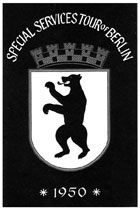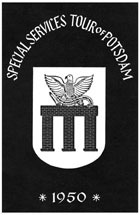Jump to the Table of Contents
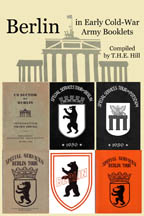 |
Berlin in Early Cold-War Army Booklets
The historical background behind Voices Under Berlin
This is a reprint of a series of six army booklets on Berlin, covering the period from 1946 to 1958, two years after the Russians shut down the CIA cross-sector tunnel that served as the background for the novel "Voices Under Berlin". The booklets represent part of the research that went into the novel. The booklets are written from a single institutional viewpoint, that of the United States Military Command in Berlin. When read in parallel, the booklets create a sense of living history, because, while they cover the same topics of interest about Berlin, their coverage of these topics changes as the series progresses, and you can see the political relationships of the time change before your eyes. The reprint is indexed and the changes in the text from one edition to the next of the individual booklets are highlighted for ease of comparison. To help better define the historical context of the booklets the reprint is provided with a Berlin Chronology. For all vets of Berlin Brigade.
The decision to reproduce these booklets was based on a number of considerations, number one of which was preservation. A number of the copies in my collection are distressed, and this project will put a stop to their deterioration. In addition, not a one of these booklets is to be found in a search of WorldCat, the on-line catalogue of a consortium of libraries, headed by the Library of Congress. Reprinting will make them available for research libraries to add to their collections.
The second consideration is that—when presented in a single volume—these booklets have a historical value that is greater than the sum of the individual booklets in isolation. The booklets all represent a single institutional viewpoint, that of the United States Military Command in Berlin. When read in parallel, the booklets create a sense of living history, because, while the booklets cover the same topics of interest about Berlin, their coverage of these topics changes as time goes by. Making it possible to compare these changes is the “value added” to this collection of booklets by reprinting them in a single volume.
The role of Hitler and the Nazis moves further and further into the background as the series progresses, as does the amount of war damage noted. At the same time, the relationship between the USSR and the USA can be seen to rearrange itself.

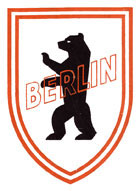
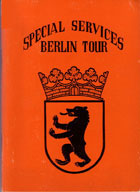
The descriptions of Unter den Linden in the various booklets provide an excellent example. In the 1946 booklet, Unter den Linden is described “formerly one of Europe’s most beautiful streets,” but now a “highway of destruction,” where “[n]early all public buildings, and most of the commercial centers are now heaps of rubble or broken fragments of walls standing like monoliths stark against the gray sky.”
The 1950 booklet calls Unter den Linden “Berlin’s most famous boulevard, … [s]o named because of the double avenue of lime or linden-trees planted here. Hitler had the famous trees cut down and replaced with tall flag poles on which the Nazi banners were hung for parades and rallies.” New trees have been planted, says the 1950 booklet, but “[o]n either side of Unter den Linden can be seen ruins of what were once the finest palaces, embassies, museums and great hotels in Germany.” Reconstruction has, nevertheless, begun. Unter den Linden is now home to “[t]he Soviet House of Culture, containing lecture halls, library, art galleries and a movie house, [which] was opened March 1947 to enlighten the Germans regarding Soviet culture.”
The physical description of Unter den Linden in the 1953 booklet remains much the same as above in the 1946 and 1950 booklets, but now the reader is informed that Unter den Linden is in “the Soviet Sector of Berlin.” The two previous editions referred to this part of Berlin as “The Russian Sector.” The 1953 booklet also announces that Humboldt University—also on Unter den Linden—is no longer the only university in Berlin. The booklet says that “[a]fter the occupation and the dividing of Berlin, many of the postwar students left the Soviet Sector and founded the Free University of Berlin.” This is the first of the booklets in which the term “Iron Curtain” appears.
The 1954 booklet makes scant mention of Hitler, and no mention at all of the destruction on Unter den Linden. Humboldt University is praised as having been “a center of free thought for all Europe,” despite being “[l]ocated on Unter den Linden a mere 200 meters from the Berlin Schloss, home and fount of Prussian absolutism and militarism.” The booklet points out that the University took a turn for the worse in “1933 when the Nazis came into power. Up to 1933 more Americans had attended Berlin’s University than any other University in Germany.” Although the 1954 booklet devotes a full share of attention to the new Free University of Berlin in the American Sector, the booklet also remarks on “the spirit of freedom fostered by Humboldt” at the University, comparing it to the spirit of freedom with which “Berlin resisted the determined attacks of the National Socialist Party long after the rest of Germany had submitted.” Freedom has obviously become the buzz word of the nascent political battle between the East and West, and the Berliners are being painted as America’s allies in this struggle.
In the 1958 booklet, the description of Unter den Linden is a tight paraphrase of the 1950 and 1953 booklets, up until the end. In the 1950 and 1953 booklets, the description concludes with “Hitler had the [famous ] trees cut down and replaced by tall flag staffs on which the Nazi banners were hung for the parades and rallies. Since 1945 new small trees have been planted.” In the 1958 booklet, those two sentences were deleted. The scars of war on Unter den Linden have begun to heal.
It is things like this that make it appealing for those interested in the history of Berlin to read these early Cold-War Army booklets in parallel. To help better define the historical context of the booklets this volume is provided with a Berlin Chronology. There is, of course, also an index.
No attempt has been made to re-edit the texts. Only blatant typographical errors have been corrected.
- Compiler's Preface page v
- Time Line of "Early Cold War" Berlin: 1945 — 1956 page ix
- U.S. Sector of Berlin: Information for New Arrivals page 1
- Published by Headquarters, Berlin District, 25 April 1946, 56 pages, map, combined with the edition of 15 July 1946.
- "Berlin," page 53
- An extract (pages 106-109) of chapter 10 "Military Communities,"
- from An Introduction to Germany for Occupation Families, published by Headquarters United States Forces European Command under supervision of the G-1 Division, prepared by the Information and Education Service, March, 1947.
- Special Services Tour of Berlin (1950) page 57
- Presented by Special Services Branch, compiled and edited by Viviane W. Adams, Berlin Military Post, 1950, 30 pages, map.
- Special Services Tour of Potsdam (1950) page 87
- Presented by Special Services Branch, compiled and edited by Viviane W. Adams, Berlin Military Post, 1950, 18 pages, map.
- Special Services Berlin Tour (1953) page 109
- Presented by Special Services Section, Berlin Military Command, [1953], 68 pages, map (same as the 1950 edition).
- Berlin (1954) page 157
- Prepared by the Public Information Office, Berlin Command, and Berlin Element, U.S. High Commission for Germany, January 1954, 64 pages, map.
- Special Services Berlin Tour (1958) page 213
- Presented by Special Services Division, Berlin Command, [1958], 112 pages, bilingual: English-German, no map. Only the English text is reprinted here. This reprint focuses on the differences between "Tour" in the 1958 and the 1953 edition. The Shopping and Entertainment Guide is not reproduced.
- Index page 239
Prices for the individual booklets on eBay range from $10 - $25, depending on the condition. At $14.95, the reprint is considerably less expensive. Buy one now.
Also in the Berlin in … Booklets series:
- Berlin in Early Berlin-Wall Era CIA, State Department, and Army Booklets This is a reprint of three booklets that the historical context of The Day Before the Berlin Wall. They cover the period from 1958 to 1966, spanning the critical year in which the Wall was built: 1961.
- Berlin in Détente-era Berlin Brigade Booklets and the Story of Berlin Brigade They cover the period from 1967 to 1975, spanning the tenth anniversary of the Berlin Wall (1971), and the beginnings of the short-lived Détente in relations with the Soviet Union.
While you are here, check out these other interesting links:
The OFFICE OF THE U. S. HIGH COMMISSIONER FOR GERMANY, BERLIN published a booklet entitled A SURVEY OF BERLIN on JULY 1, 1950.
The feature article in the May 1959 issue of Army Digest was on Berlin. Follow me to read it.
The November 1961 issue of Army Digest carried a photo montage of the U.S. Army responding to the Communist challenge on the front lines of freedom in Berlin.
The August 1969 issue of Army Digest ran an article on the Berlin Duty train.
Also by this author: three award-winning Berlin novels:
Voices Under Berlin: The Tale of a Monterey Mary


